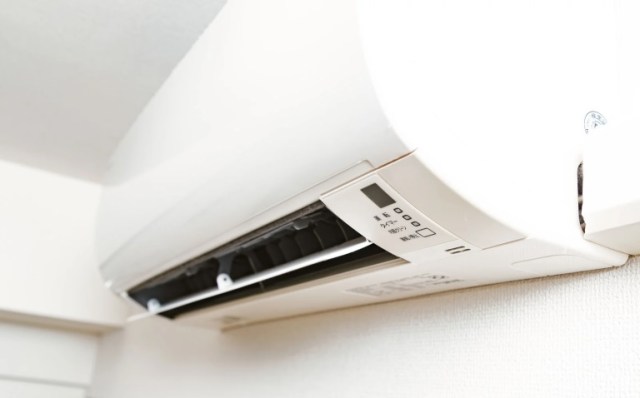
Summer in Japan will always be hot and humid, but your apartment doesn’t have to.
Summer is hot and humid in Japan, and this year especially so. So it’s kind of surprising that in a recent survey from air conditioner manufacturer Daikin, quite a few people said they don’t like running their air conditioner in the summer.
Daikin collected responses from 1,046 people between the ages of 20 and 69, with about one in three saying that they keep their AC off during the summer. When asked why, the two most common responses were the electricity costs of running the AC and “hadasamusa,” which translates literally to “cold skin” and refers to an unpleasant chilly sensation.
You’ll notice, though, that neither of those reasons necessarily means that the person feels comfy with the AC off. So thankfully Daikin has some pointers for how to use your air conditioner to make your living space feel cool but not cold, and also how to keep your electricity costs down. And while it’s Daikin doling out the advice, it applies to pretty much any and all air conditioning units available in Japan, not just the ones Daikin makes. If you grew up in a country where centralized AC is the norm, like the U.S., these tips could be lifesavers if you’re transitioning to living in Japan right now.
1. Make sure your AC’s external equipment has an unimpeded air flow
▼ You want it to look like the picture on the left, not the one on the right.
Japanese air conditioners tend to have two parts: the interior equipment (the vents inside your apartment that blow out cold air) and the external equipment (the compressor and exhaust). Generally, the external equipment will be on your balcony, but given the compact size of Japanese homes, you might have some assorted clutter out there too. If you are storing stuff on the balcony, though, you’ll want to make sure that’s it’s not covering the air conditioner’s air intake or exhaust, though. Keeping those unobstructed and freely flowing is key to keeping the air blowing properly from the AC vents in your interior, which is critical for avoiding wasted electricity.
2. Clean your interior filters
▼ Again, left picture good, right picture bad.
The interior part of your unit has filters inside of it, and there should be an access panel that you can flip open or remove (the exact method varies by unit, but should be diagrammed in the instruction manual). Over time, these filters will fill up with dust and other airborne debris and keep the full amount of air from blowing out, with that inefficiency translating to wasted energy and a higher electricity bill since the AC is having to work harder to cool the room. Daikin recommends opening up the access panel and cleaning the filters once every two weeks, but even a single summertime cleaning goes a long way, so it’s something you’ll want to do at least once per season (preferably in the spring, but better late than never).
3. Angle of attack
▼ This time the image on the right is what you want to do.
Japanese air conditioners are usually mounted up near the ceiling and allow you to select the angle at which the air blows out (most commonly through buttons on the AC’s remote control). You might be tempted to point the vents down at yourself so that the cold air hits you ASAP, but Daikin recommends the exact opposite: keep the AC blowing out horizontally.
Since hot air rises, prior to turning on the AC the temperature is going to be higher up near the ceiling that it is down on the floor. Shooting the cold air downward at a steep angle is going to make the temperature gap even bigger, and that’s going to create humidity. As anyone who’s been through a Japanese summer can tell you, it’s the mugginess that can really make things brutal, more so than the heat. By keeping your AC blowing out horizontally, you’ll even out the temperature throughout the room, and the uniform conditions will help keep you from feeling sweaty and clammy, and as an added bonus, not getting hit directly with cold air will also alleviate that unwanted chilly hadasamusa sensation.
4. Get to know joshitsu unten
There can be a lot of buttons on Japanese AC remote controls, and a lot of them are labeled with words that might not have come up in a Japanese language class. One of the first ones you’re going to want to familiarize yourself with, though is joshitsu unten / 除湿運転, or the dehumidifier function.
Like we talked about above, “It’s not the heat, it’s the humidity” might be a cliche, but it’s also the absolute truth about summer in Japan. So pretty much all modern AC units sold in Japan now have not only cooling functions, but dehumidifying ones too. If the conditions inside your apartment are sweaty but not necessarily hot, hit the 除湿運転 and your AC will give you some relief without drastically dropping the temperature. Many AC units also have a jidou unten (自動運転), or “automatic operation,” function, in which it’ll automatically combine dehumidifying and mild cooling in the necessary proportions to maximize comfort.
Depending on how sensitive you are to the heat and humidity, we can’t promise that following these tips will leave you completely unbothered by the summer weather, but they’ll definitely make it a lot more bearable, especially if you throw in the occasional Gaburi Peach Frappuccino or giant shaved ice with fire for some extra cooling.
Source: Newscast
Top image: Pakutaso
Insert images: Newscast, SoraNews24
● Want to hear about SoraNews24’s latest articles as soon as they’re published? Follow us on Facebook and Twitter!
[ Read in Japanese ]
Follow Casey on Twitter, where he actually has no complaints about Japan’s hot summer nights.
[ Read in Japanese ]





 Here’s one of the first things you should do if you just moved into a new apartment in Japan
Here’s one of the first things you should do if you just moved into a new apartment in Japan It’s so hot in Japan that people are cooking food in/on their cars【Photos】
It’s so hot in Japan that people are cooking food in/on their cars【Photos】 Japanese summer is worse than summer in Death Valley, says our correspondent, a seasoned traveler
Japanese summer is worse than summer in Death Valley, says our correspondent, a seasoned traveler Nintendo issues warning to make sure your Switch can handle the heat this summer
Nintendo issues warning to make sure your Switch can handle the heat this summer The ultimate in water recycling: we try taking a bath in our dehumidifier water
The ultimate in water recycling: we try taking a bath in our dehumidifier water Foreigner’s request for help in Tokyo makes us sad for the state of society
Foreigner’s request for help in Tokyo makes us sad for the state of society Japanese city loses residents’ personal data, which was on paper being transported on a windy day
Japanese city loses residents’ personal data, which was on paper being transported on a windy day Should you add tartar sauce to Japanese curry rice? CoCo Ichi makes diners an unusual offer
Should you add tartar sauce to Japanese curry rice? CoCo Ichi makes diners an unusual offer Seaside scenery, history, and so many desserts on Yokohama’s Akai Kutsu【Japan Loop Buses】
Seaside scenery, history, and so many desserts on Yokohama’s Akai Kutsu【Japan Loop Buses】 Ghibli Park now selling “Grilled Frogs” from food cart in Valley of Witches
Ghibli Park now selling “Grilled Frogs” from food cart in Valley of Witches Harajuku Station’s beautiful old wooden building is set to return, with a new complex around it
Harajuku Station’s beautiful old wooden building is set to return, with a new complex around it Japanese breast size study shows rapid growth in previously smallest-busted region of county
Japanese breast size study shows rapid growth in previously smallest-busted region of county Is Starbucks Japan’s new Gohobi Melon Frappuccino really the ultimate melon Frappuccino?
Is Starbucks Japan’s new Gohobi Melon Frappuccino really the ultimate melon Frappuccino? Historical figures get manga makeovers from artists of Spy x Family, My Hero Academia and more
Historical figures get manga makeovers from artists of Spy x Family, My Hero Academia and more McDonald’s new Happy Meals offer up cute and practical Sanrio lifestyle goods
McDonald’s new Happy Meals offer up cute and practical Sanrio lifestyle goods Japanese ramen restaurants under pressure from new yen banknotes
Japanese ramen restaurants under pressure from new yen banknotes French Fries Bread in Tokyo’s Shibuya becomes a hit on social media
French Fries Bread in Tokyo’s Shibuya becomes a hit on social media Studio Ghibli releases new action figures featuring Nausicaä of the Valley of the Wind characters
Studio Ghibli releases new action figures featuring Nausicaä of the Valley of the Wind characters New private rooms on Tokaido Shinkansen change the way we travel from Tokyo to Kyoto
New private rooms on Tokaido Shinkansen change the way we travel from Tokyo to Kyoto Red light district sushi restaurant in Tokyo shows us just how wrong we were about it
Red light district sushi restaurant in Tokyo shows us just how wrong we were about it Tokyo Tsukiji fish market site to be redeveloped with 50,000-seat stadium, hotel, shopping center
Tokyo Tsukiji fish market site to be redeveloped with 50,000-seat stadium, hotel, shopping center All-you-can-drink Starbucks and amazing views part of Tokyo’s new 170 meter-high sky lounge
All-you-can-drink Starbucks and amazing views part of Tokyo’s new 170 meter-high sky lounge Beautiful Ghibli sealing wax kits let you create accessories and elegant letter decorations【Pics】
Beautiful Ghibli sealing wax kits let you create accessories and elegant letter decorations【Pics】 Studio Ghibli releases Kiki’s Delivery Service chocolate cake pouches in Japan
Studio Ghibli releases Kiki’s Delivery Service chocolate cake pouches in Japan New definition of “Japanese whiskey” goes into effect to prevent fakes from fooling overseas buyers
New definition of “Japanese whiskey” goes into effect to prevent fakes from fooling overseas buyers Our Japanese reporter visits Costco in the U.S., finds super American and very Japanese things
Our Japanese reporter visits Costco in the U.S., finds super American and very Japanese things Studio Ghibli unveils Mother’s Day gift set that captures the love in My Neighbour Totoro
Studio Ghibli unveils Mother’s Day gift set that captures the love in My Neighbour Totoro More foreign tourists than ever before in history visited Japan last month
More foreign tourists than ever before in history visited Japan last month New Pokémon cakes let you eat your way through Pikachu and all the Eevee evolutions
New Pokémon cakes let you eat your way through Pikachu and all the Eevee evolutions Sales of Japan’s most convenient train ticket/shopping payment cards suspended indefinitely
Sales of Japan’s most convenient train ticket/shopping payment cards suspended indefinitely Sold-out Studio Ghibli desktop humidifiers are back so Totoro can help you through the dry season
Sold-out Studio Ghibli desktop humidifiers are back so Totoro can help you through the dry season Japanese government to make first change to romanization spelling rules since the 1950s
Japanese government to make first change to romanization spelling rules since the 1950s Ghibli founders Toshio Suzuki and Hayao Miyazaki contribute to Japanese whisky Totoro label design
Ghibli founders Toshio Suzuki and Hayao Miyazaki contribute to Japanese whisky Totoro label design Doraemon found buried at sea as scene from 1993 anime becomes real life【Photos】
Doraemon found buried at sea as scene from 1993 anime becomes real life【Photos】 Tokyo’s most famous Starbucks is closed
Tokyo’s most famous Starbucks is closed One Piece characters’ nationalities revealed, but fans have mixed opinions
One Piece characters’ nationalities revealed, but fans have mixed opinions We asked a Uniqlo employee what four things we should buy and their suggestions didn’t disappoint
We asked a Uniqlo employee what four things we should buy and their suggestions didn’t disappoint Princesses, fruits, and blacksmiths: Study reveals the 30 most unusual family names in Japan
Princesses, fruits, and blacksmiths: Study reveals the 30 most unusual family names in Japan Promotion offers perfect one-week living space for otaku: An apartment pre-stocked with manga
Promotion offers perfect one-week living space for otaku: An apartment pre-stocked with manga Single snake sparks power outage for nearly 10,000 homes in Fukushima
Single snake sparks power outage for nearly 10,000 homes in Fukushima Sony’s wearable air conditioners selling like cold cakes in heat-stricken Japan
Sony’s wearable air conditioners selling like cold cakes in heat-stricken Japan Chilling manga shows why sleeping with window open can be a dangerous way to beat summer heat
Chilling manga shows why sleeping with window open can be a dangerous way to beat summer heat Japanese gamer girl’s crazy controller grip shocks Internet, is unintentional blast from the past
Japanese gamer girl’s crazy controller grip shocks Internet, is unintentional blast from the past Japan’s semi-functional air conditioner capsule toys promise to help us cope with the summer heat
Japan’s semi-functional air conditioner capsule toys promise to help us cope with the summer heat Japanese netizens shook by ancient air conditioner remote 【Photos】
Japanese netizens shook by ancient air conditioner remote 【Photos】 Adorable Pikachu Butt USB AC adapter is now the cutest way to charge your devices
Adorable Pikachu Butt USB AC adapter is now the cutest way to charge your devices What’s it like to pole dance on a rooftop in Tokyo?
What’s it like to pole dance on a rooftop in Tokyo? Try a super-easy summer cold remedy with this natural Honey Daikon Cough Syrup recipe
Try a super-easy summer cold remedy with this natural Honey Daikon Cough Syrup recipe Japanese banana importer teaches us how to enjoy bananas and fight heatstroke at the same time
Japanese banana importer teaches us how to enjoy bananas and fight heatstroke at the same time Japan has a random hotel room gacha capsule vending machine
Japan has a random hotel room gacha capsule vending machine No electricity? No problem! Empty plastic bottles are helping to cool homes in impoverished areas
No electricity? No problem! Empty plastic bottles are helping to cool homes in impoverished areas Beat the heat in the smelliest arena with clip-on armpit fans from Japan!
Beat the heat in the smelliest arena with clip-on armpit fans from Japan!
Leave a Reply